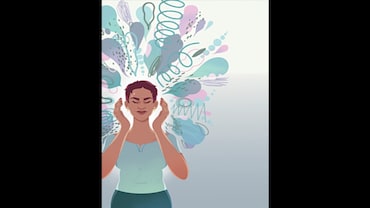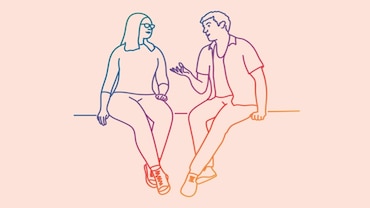- HOME
- /
- Better Living
- /
- Parenting
- /
The Blue Whale and Other Predators
It's time to build safe spaces for our children, away from the dark side of the internet.

"I am trapped in the game which I have been playing for the last two months. I am now in the final stage and they are telling me to commit suicide otherwise they will kill my parents. Please help me." A Class X student from Madhya Pradesh scribbled these desperate words on his answer sheet during an examination this September. He had reached the 49th stage of the Blue Whale Challenge, a clandestine and sinister online game that pushes vulnerable young people to perform escalating acts of self-harm over 50 days, which culminates in suicide. Fortunately, the student's call for help did not go unanswered and currently he is undergoing extensive counselling.
Although the alleged creator of the game, a 21-year-old Russian student of psychology, is languishing in jail, the phenomenon itself has spread like wildfire across Russia, Brazil and China. After crisscrossing Europe, it has now reached India. There have been reports from towns in Maharashtra, Kerala, West Bengal and Punjab, and cities like Indore and Dehradun, of young people playing this game and mutilating themselves. At least four to five of them have allegedly ended their lives.
THE GRIM REALITY
Let's just step back and make a note of the underbelly of this sordid phenomenon. The World Health Organization, in its 2015 findings, suggests that India has one of the highest rates of suicide in the world. A study published in The Lancet recently noted that 62,960 young people, between the ages of 10 and 24 years, committed suicide in one calendar year (2013) in India. This is most certainly an underestimate, as many families tend to conceal such incidents. It is estimated that every hour one student ends her or his life. Suicide is the number one cause of death amongst this age group in India, ahead of road accidents, the main cause in the rest of the world.
Compared to these shocking revelations, the Blue Whale Challenge may seem insignificant, but despite this the wave of concern and media coverage has provided us with the opportunity to ask a few pertinent, yet urgent questions: Who are the kids joining this lethal game? What is it symptomatic of? What are the dangers lurking in social media? How can we make it safer for our kids? What kind of controls can we have over our kids' lives? Who and how can these help?
It is important to understand that all children do not fall prey to the Blue Whale Challenge or other forms of cyberbullying. There are numerous websites that can entice young people towards self-harm and suicidal behaviour. Cyberbullying is also rampant with 32 per cent of parents saying their children experienced it, according to a 2014 Ipsos/Reuters poll. It also takes sinister forms in seemingly innocuous social media spaces.
Take the case of a bright, talented 14-year-old girl who came to us recently with severe depression and tendencies for self-harm. Jealous of her achievements, some of her so-called friends had morphed her picture in indecent forms and circulated them on the school WhatsApp group, along with humiliating comments. They followed it up with nasty remarks and questions about when and how she was planning to end her life. It took a while for the girl to gather up the courage and tell her parents about it. They were shocked at the harassment and bullying their daughter had faced without their knowledge.
WHO IS MOST VULNERABLE?
Young people who are most vulnerable to predatory sites and games are usually troubled, perhaps depressed and looking to channelize their torment in some way. From their dark space of hopelessness and loneliness, an avenue like the Blue Whale Challenge may provide them with a sense of purpose and belonging, despite the evident dangers. About two thirds of young people who successfully end their lives are found to be clinically depressed in retrospect. The breakdown of socio-cultural structures and an intrusive social media has taken a huge toll on the younger generation and their mental health. Add cut-throat competition and the need for urgent material gratification to this and we have a recipe for disaster.
What is alarming, perhaps, is that most parents, teachers and other responsible adults have no idea about an adolescent's inner world until they hit a raging crisis. Young people know and navigate the complex world of social media like we adults interact with close friends and family. To believe that we, from the outside, can control their intimate space is naive and destined for failure.
WHAT CAN BE DONE
But it's not all doom and gloom. Social media, when used judiciously, can be enriching. I believe, it is the duty of adult stakeholders along with responsible young people, to shape and build safe spaces for our children. Here are a few things we can do.
- Parents often drift away from their children when they step into adolescence. During parenting workshops, we consistently find packed houses with junior school parents, but they become a handful in senior school. Despite her outward bristly persona, your teenager might need you to help scaffold her inner turmoil. You have to commit time and energy to maintain your relationship, which is central to every other thing. Listen, share, empathize and don't make judgements about their friends or the music they listen to. Then, they might let you peek into their inner world. Talk to them about safety, boundaries, issues of trust and respect without being preachy. Tough to do, but you may need to dig deep to strike a delicate balance between being a friend and a parent.
- Schools have a huge role in building communities that are fragmenting. Ensuring emotionally safe spaces-an inclusive attitude where cooperation is held higher than competition, fostering emotional awareness and pro-social skills and strong anti-bullying policies go a long way in preventing tragic events. Life skills education, including safe use of social media, is imperative in today's changing climate. One school, in the wake of the Blue Whale Challenge, spoke to students and wrote informative emails to parents to ensure a support network. Way to go.
- The state cannot shift responsibility onto parents and schools whenever there is a crisis. A punitive and policing approach with CCTV cameras seems good to the public eye, but research indicates it does not produce any lasting results. The state needs to work alongside parents and schools through policy and consistent implementation to ensure emotional and social safety. Inclusive systems and holistic education, where teacher training/sensitization and life skills education become mandatory, are a dire need in the Blue Whale age.
Dr Amit Sen is director and senior child and adolescent psychiatrist, Children First, New Delhi.






